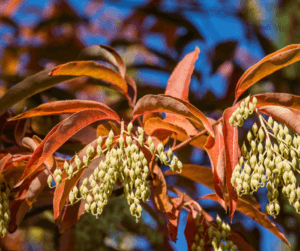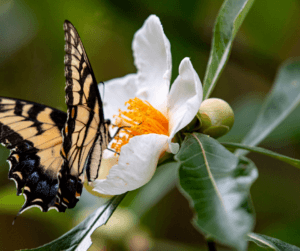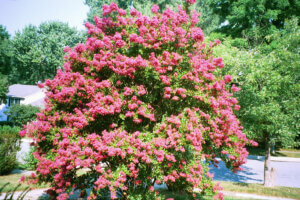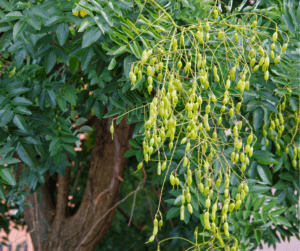
In spring the whole world seems to bloom, with a wide array of flowering trees and shrubs joining the parade of daffodils, tulips and hyacinths. The pace of mid to late summer is slower, which gives gardeners and flower lovers more time to appreciate the changing show.
If you are thinking about including a summer-flowering tree in your landscape, the choices are varied, from the cascading fringe of sourwood, to the camellia-like blossoms of the native Franklinia tree. While not so numerous as the spring-flowering trees, summer bloomers come in all sizes and configurations. If you happen to have an arboretum, you can have them all. For the rest of us, the hardest part is choosing only one.
The Sweetness of Sourwood
Known for its (allegedly) bitter leaves and decidedly sweet fragrance, sourwood (Oxydendrum arboretum) is a deciduous native of the southeastern United States. Related to members of the heath and heather or Ericaceae plant family, the species is also known as “Sorrel tree”, or, more sweetly, “lily-of-the-valley tree”. In cultivation sourwoods grow to about 25 to 30 feet tall and about 20 feet wide, with shining, oval-shaped leaves that are green in summer and brilliant red or red-purple in the fall. In very late June or July, sourwood trees are completely clothed in drooping flower panicles made up of tiny, individual chalice or urn-shaped blooms that last up to a month, spilling out over the leaves and giving the trees a singular appearance.
Well-drained soil and full sun to light shade make for happy sourwoods, and the trees are hardy in USDA Zones 5 through 9. Lovers of variegated leaves may be interested in Oxydendrum arboretum ‘Albomarginatum’, which boasts white leaf edges.

Franklin’s Tree
Perhaps fittingly for something discovered during America’s colonial period, the Franklinia tree (Franklinia alatamaha) is a member of the tea family. Other notable members include camellias, so it is no coincidence that the beautiful Franklinia flowers, which appear in late July, August and sometimes into September, are camellia-like.
Franklinias, hardy in USDA Zones 5 through 8, are especially appropriate for smaller gardens, growing between 10 and 20 feet tall and up to 15 feet wide, with spreading branches. The glossy leaves are narrowly tapered ovals with soft undersides. In the fall those leaves turn red to purple.
The tree’s greatest glory, however, may be the fragrant flowers, which are white, with five petals apiece surrounding a sumptuous boss of golden stamens.
Franklinias like well-drained soil on the acidic side of the ph scale. To get the best from the plant add organic material, like Fafard Garden Manure Blend to the soil when filling the planting hole.
Discovered in the wilds of Georgia in 1770, Franklinia disappeared from its habitat sometime afterwards. Thanks to colonial plantsman John Bartram, who collected the seeds and named the newly discovered species after his friend, Benjamin Franklin, last summer flower lovers can enjoy Franklinia today.

Great Crape
Crape myrtle (Lagerstroemia sp.) is a small tree that generally tops out at 15 to 25 feet. The many available varieties shine with brilliant summer flower panicles or branching clusters composed of scores of individual six-petaled blooms in shades including white, a range of pinks and roses, dark red and lavender. Crape myrtle flowers are spellbinding when they bloom, but the plants pull their weight in all four seasons. The leaves, which are oblong and appear in groups of three, tend to be smooth and glossy green, coloring up in the fall in shades of red, orange and yellow. Most varieties also have smooth grayish bark that exfoliates or peels off to reveal underbark that may be brown, gray or even pinkish. The effect is like elegant camouflage, and it makes crape myrtles stand out during the cold months when leaves and flowers are a thing of the past.
The most common crape myrtles in commerce are varieties or hybrids of Lagerstroemia indica, which is native to parts of Asia, and the list of colors and sizes is long.
Crape myrtles like the same conditions as roses—full sun for at least six hours per day. If your chosen site receives a little less light, the tree or shrub may still thrive but will likely produce fewer flowers. Plant in well-drained soil enriched with organic material and mulch thoroughly.
If crape myrtle can be said to have a downside, it may be zone hardiness. Older varieties are probably only hardy from USDA Zone 6 or 7 through Zone 9. Newer cultivars have been bred for greater cold tolerance, but it pays to check plant tags before purchasing.

Perfect Pagodas
A tall, upright, deciduous tree with spectacular late summer flowers, the Japanese pagoda tree (Sophora japonica) is not native to Japan, but hails from China. Reaching 50 to 75 feet tall, with a nearly equal spread, it is majestic, perfect as a specimen or even street tree. Pagoda trees sport medium green leaves that are pinnate, with each five to ten inch “leaf” composed of a number of short leaflets that sprout from a single stem. In July or August, those leaves are complemented by elongated clusters of pea-like white flowers that are lightly fragrant and attract pollinators. After the petals drop, the yellow-green seed pods appear, hanging from the trees like strings of beads. Eventually those pods turn brown and split.
Japanese pagoda trees prefer full sun to part shade, and well-drained loamy soil. Once established they are tolerant to environmental stressors, including air pollution. The most popular variety is ‘Regent’, which grows more quickly than the species. Pagoda trees are hardy in USDA Zones 6 through 9.

And For Colder Climates…
If you live in USDA Zones 3 or 4, where winters are colder, you can still grow trees with late summer flowers. Panicle hydrangea (Hydrangea paniculata), can be grown either as a shrub, or, as is often the case, trained (either by a nursery or by the gardener) to grow as a small tree. In tree form, it can grow up to 15 feet tall with a wide crown. From July through September the hydrangea will bloom, producing fat, conical flower panicles composed of scores of individual white blossoms that eventually age to pink and then ten. Hardy in USDA Zones 3 through 8, panicle hydrangeas are also tolerant of air pollution, but dislike drought. Plant in full sun and provide supplemental water during hot, dry weather.



